Archive for August, 2019
Public invited to UToledo simulation training for staying safe during mass violence incident
Thursday, August 29th, 2019The community is invited to attend a free simulation training to learn how to prepare and respond in a mass violence incident.
The University of Toledo is hosting “S.T.R.I.V.E. to Survive” in partnership with the Lucas County Sheriff’s Office from 6 to 7 p.m. Tuesday, Sept. 3 at the West Toledo Branch Library, 1320 W. Sylvania Ave. in Toledo.
The experts will teach threat assessment, situational awareness, tourniquet application and recovery following a mass violence event.
“Shortly after the El Paso and Dayton shootings, I read numerous posts on social media from Toledoans expressing their fear of going to restaurants, retail stores and concerts,” said Dr. Lisa Pescara-Kovach, associate professor of educational psychology and chair of the UToledo Mass Violence Collaborative. “In response, this active training is the first of several events we are organizing in collaboration with the Lucas County Sheriff’s Office to share our knowledge with the entire community to save lives.”
The second community training is scheduled from 6 to 7 p.m. Tuesday, Sept. 24 in the Jacobs Interprofessional Immersive Simulation Center on UToledo Health Science Campus.
U.S. Department of Energy awards UToledo $750,000 to improve production of hydrogen as clean fuel
Thursday, August 29th, 2019From powering a car to a rocket, hydrogen holds promise as the clean-energy fuel of the future.
The University of Toledo is among 29 universities and organizations across the country to receive a total of $40 million from the U.S. Department of Energy for new projects focused on using hydrogen as fuel.
The goal of the H2@Scale concept is to enable affordable and reliable large-scale hydrogen generation, transport, storage and utilization in the United States and beyond.
NASA’s mission to Mars hinges on the ability to split water – in the form of ice – to produce hydrogen on the moon as fuel to reach the Red Planet.
Hydrogen also could be used on Earth to keep the electrical grid operating to power homes and businesses in the face of extreme weather or cyberattacks.
UToledo was awarded $750,000 to improve water-splitting, the process of breaking apart the water molecule, separating hydrogen from oxygen. The hydrogen, which produces only water when consumed in a fuel cell, can then be used as a clean fuel.
The photovoltaics team, led by Dr. Yanfa Yan, UToledo professor of physics, and Dr. Zhaoning Song, research assistant professor in the UToledo Department of Physics and Astronomy, will develop low-cost photoelectrodes for more efficient photoelectrochemical water splitting using innovative material from their highly successful perovskite solar cells. Perovskites are compound materials with a special crystal structure formed through chemistry.
The perovskite cells can have high efficiency, collecting more of the sun’s energy and transforming it into the electricity needed to split the water molecule and produce hydrogen.
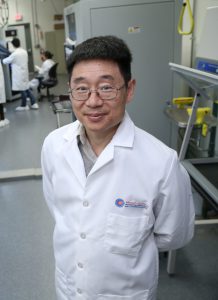
Dr. Yanfa Yan, professor of physics
“Perovskite absorbers have drawn extensive attention due to their demonstrated capability of fabricating solar cells with outstanding conversion efficiencies,” Yan said. “We are excited about this opportunity and eager to apply perovskite absorbers to advance the photoelectrochemical water-splitting technology.”
Funded through the U.S. Department of Energy’s Office of Energy Efficiency and Renewable Energy (EERE) with contribution from DOE’s Office of Nuclear Energy, the selected projects will advance hydrogen storage and infrastructure technologies and identify innovative concepts for hydrogen production and utilization including electrical grid resiliency.
“The H2@Scale concept is a critical piece of the country’s comprehensive energy strategy and an enabler of multiple industries in our economy,” said U.S. Secretary of Energy Rick Perry. “As an energy carrier, hydrogen has the potential to unite our nation’s domestic energy resources. These selections support the Department of Energy’s mission and advances our commitment to enable economic growth and energy security through the development of more affordable hydrogen technologies.”
“Toledo is at the forefront of the development of innovative technologies that move our country and our world further,” said Congresswoman Marcy Kaptur. “I am pleased to see that The University of Toledo has been awarded this valuable $750,000 grant from the Department of Energy to facilitate the University’s important research into hydrogen as clean fuel and to cement our region as a clean energy, research and manufacturing hub.”
The U.S. produces more than 10 million tons of hydrogen, nearly one-seventh of the global supply, primarily for oil refining and fertilizer production.
Hydrogen infrastructure includes more than 1,600 miles of hydrogen pipeline, a growing network of stations, and thousands of tons of storage in underground caverns.
Scientists discover single gene that explains songbird migration
Wednesday, August 28th, 2019Ornithologists at The University of Toledo played a critical role in new collaborative research identifying a single gene that defines whether rare, tiny songbirds that reproduce in the Great Lakes region and Appalachian Mountains spend their winters in South America or Central America.
Dr. Henry Streby, assistant professor in the UToledo Department of Environmental Sciences, and Gunnar Kramer, Ph.D. candidate in environmental sciences and UToledo graduate dean’s fellow, laid the groundwork for the genetics discovery published this week in the journal Proceedings of the National Academy of Sciences.

Golden-winged warbler
With collaborators at Cornell University, Penn State and the University of Colorado, the team’s findings may have important conservation implications for the declining populations of golden-winged warblers.
Starting six years ago, the UToledo team led a massive collaborative field study: across eastern North America, they caught golden-winged warblers on their breeding grounds, gathered blood samples, placed tiny geolocator technology on the birds, and completed long-distance, cutting-edge migration tracking analysis. Streby and Kramer then gave the samples and data to genetics researchers at Penn State and the Cornell Lab of Ornithology, who performed whole genome resequencing.
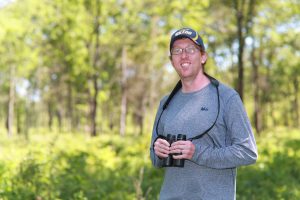
Henry Streby
“Only one gene tells the story of the final wintering destination, and it makes sense because it is affiliated with muscles and movement in humans,” Streby said. “Migration is a very complex set of behavioral and physiological traits, and we know this one gene can’t be responsible for all of it. But it’s a critical first step that gives everyone in the field something to build on. This exciting ecology and evolutionary discovery proves the powerful potential of research collaboration.”
Streby and Kramer had already answered the question of where these birds go: golden-winged warblers from declining populations spend winters in northern South America. Stable populations of the species spend winters in Central America.
Researchers at the collaborating universities then used the data and blood samples from the migrating birds to investigate genetic differences between birds that winter in Central America and those that winter in South America. The majority of these differences occurred in a small region on the bird’s Z chromosome, a sex-determining chromosome like the X and Y chromosomes in humans. Only one gene, called VPS13A, was present in this region.
Although the gene does not yet have any known function in birds, in humans it is associated with the neurodegenerative disorder chorea-acanthocytosis, which affects movement.
“In this study, we found only one gene associated with the final wintering destination of golden-winged and blue-winged warblers,” said Dr. David Toews, assistant professor of biology at Penn State and leader of the research team. “As we come to better understand the role of this gene in humans, we may also gain important insights to its role in migration in birds.”
According to the researchers, the gene appears to be a target of natural selection in birds that winter in South America.
“Golden-winged warblers are rapidly declining in the Appalachian Mountains. Conservation efforts have focused on protecting the breeding grounds, which is important, but declines also appear strongly related to habitat alteration and destruction in the wintering grounds,” Streby said.
“The global attention on the fires in the Amazon highlight the importance of these South American habitats, and these migratory birds illustrate an inextricable link between hemispheres,” Toews said.
For Streby and Kramer at UToledo, collecting blood samples from the golden-winged warblers to be used for a later genetics’ investigation was a side project to their study identifying the migratory connectivity of the species. They also recorded the birds singing across their whole range and collected feather samples.
It’s what Streby calls “while-you’re-there science.”
“It’s important to conduct all of the useful science while you have the opportunity because you can’t fund six different projects by six research teams to address six questions in the same study system,” Streby said. “For the DNA samples, we knew we needed to find the right researcher who was looking for migration genes.”
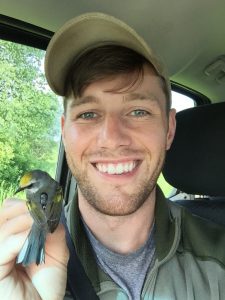
Gunnar Kramer held a golden-winged warbler, which carried a geolocator. Researchers attached the tiny backpack to the bird in 2015 and recovered it in 2016. The data on the geolocator helped Kramer understand the warbler’s migratory route and winter location.
Kramer met Toews and Dr. Scott Taylor, assistant professor of ecology and evolutionary biology at the University of Colorado, at the North American Ornithological Conference in Washington, D.C., in 2016.
“I quickly realized we had valuable genetic samples that they needed to do exciting complementary research, and we were happy to share our science,” Kramer said. “By working together, we now know what we suspected – there is a genetic component to migration. However, we’re fascinated it appears to be just one gene that explains the major migration divide in the system.”
The study was supported by the Natural Sciences and Engineering Research Council of Canada, the National Science Foundation, The University of Toledo, the Cornell Lab of Ornithology, the United States Geological Survey, the United Sates Fish and Wildlife Service, the University of Minnesota and the University of Tennessee.
UToledo to launch kayaking on campus as students are welcomed back
Tuesday, August 20th, 2019The University of Toledo is welcoming students for the 2019-20 academic year with the debut of kayaking on campus, newly renovated classrooms and fun events to celebrate and motivate for a successful, engaging semester.
UToledo President Sharon L. Gaber will roll up her sleeves to help students unpack their belongings and move into their residence hall from 10 to 11 a.m. Friday, Aug. 23 at Parks Tower.
Fall classes at UToledo begin Monday, Aug. 26.
 The University will host a ribbon-cutting ceremony to unveil the new kayak launch and pedestrian bridge leading to Savage Arena 3:30 p.m. Wednesday, Aug. 28 near lot 2 along North Towerview Blvd. The prefabricated steel truss bridge features a redesigned plaza with a seating area at the north end overlooking the Ottawa River.
The University will host a ribbon-cutting ceremony to unveil the new kayak launch and pedestrian bridge leading to Savage Arena 3:30 p.m. Wednesday, Aug. 28 near lot 2 along North Towerview Blvd. The prefabricated steel truss bridge features a redesigned plaza with a seating area at the north end overlooking the Ottawa River.
“We look forward to the return of the energy and excitement that students bring to a new academic year,” Gaber said. “With the addition of Lime scooters last year and now kayaks, we are offering a variety of fun ways for students to enjoy our beautiful campus and community.”
Recreational Services will provide kayaks, paddles, life vests and helmets from 10 a.m. to 6 p.m. seven days a week. Kayak rental is free with a membership to the Student Recreation Center.
Soccer games are returning to Main Campus for the first time in 23 years. A dedication ceremony for the new soccer field – Paul Hotmer Field – will be held prior to kickoff of the first match 7 p.m. Thursday, Aug. 29 when the women’s soccer team takes on the University of Illinois at Chicago.
Three new active learning centers are opening on the second floor of Snyder Memorial this fall semester and one in Gillham Hall. These technology-rich classrooms are designed to allow students to collaborate with each other, share work in progress, get rapid feedback, and provide instructors with access to all parts of the classroom.
UToledo renovated the auditorium in McMaster Hall over the summer and eight classrooms in Stranahan Hall. Two of those are computer labs for the College of Business and Innovation, and six are general purpose tiered classrooms.
New Rockets will be welcomed to UToledo at the New Student Convocation at 4 p.m. Sunday, Aug. 25 in the Glass Bowl (Rain location: Savage Arena) when Gaber and faculty and staff members will greet new students and talk about what it means to be a Rocket. The event will be followed by a barbecue in the Flatlands.
During the first few weeks of classes, the Office of Student Involvement and Leadership in the Division of Student Affairs has planned a number of events to encourage students to meet new friends, have fun and learn about the University.
The events to welcome students to the new school year include:
Friday, Aug. 23
- Paint Party, 8 p.m., the Flatlands. Students are invited to dance, paint and make new friends. This event is sponsored by Campus Activities and Programming.
Monday, Aug. 26
- Sundae on a Monday with President Gaber, 4 p.m., Centennial Mall. Meet President Gaber and taste free ice cream.
Wednesday, Aug. 28
- Student Involvement Fair and Part-Time Job Fair, 11 a.m. to 2:30 p.m., Centennial Mall. Rain locations: Thompson Student Union Auditorium and Rooms 2582 and 2584.
Thursday, Aug. 29
- Women’s Soccer Match, 7 p.m., Paul Hotmer Field inside the UToledo track on the west side of Savage Arena. Be there when the Rockets return to play on Main Campus. After a dedication ceremony, Toledo will take on the University of Illinois at Chicago. Tickets are $6 and $4 for 18 and younger; UToledo employees can purhcase tickets at half price; UToledo students are admitted free with ID. Go to the Toledo Rockets’ ticket website or call 419.530.GOLD (4653).
Tuesday, Sept. 10
- President’s Backyard BBQ, noon to 2 p.m., Centennial Mall. Rain location: Health Education Center.
- Pep Rally, 12:30 p.m., Centennial Mall, steps outside Thompson Student Union.
Saturday, Sept. 14
- President’s Tailgate, 4:30 to 6:30 p.m., grass area north of Rocket Hall. Students are invited to meet President Gaber. Stop by for free food before the UToledo vs. Murray State game.
- Toledo vs. Murray State, 7 p.m., Glass Bowl. Students are admitted free with their Rocket ID; faculty and staff can buy tickets half price with ID.
For a full list of events, go to utoledo.edu/studentaffairs/welcomeweek.
August UToledo Board of Trustees Meetings
Friday, August 9th, 2019Monday, Aug. 12, 2019
Libbey Hall, Private Dining Room
5 p.m. Privileging and Credentialing Subcommittee Meeting
This Subcommittee will enter Executive Session immediately upon convening
the meeting to discuss privileged information related to the evaluation of medical
staff personnel appointments.
Libbey Hall, Third Floor Conference Room
5:30 p.m. Special Board of Trustees Meeting and Dinner
The Board of Trustees will enter Executive Session immediately upon convening
the meeting to discuss trade secret under the Ohio Uniform Trade Secret Act,
O.R.C. Section 1333.61, et. seq., the sale of property, privileged information related
to the evaluation of medical staff personnel appointments and quality reporting, and
the discipline of an employee.
Any questions may be directed to the Office of Marketing and Communications by calling 419.530.2410 or via email to meghan.cunningham@utoledo.edu.
UToledo physicists awarded more than $7 million to rev up electrical technology for space vehicles using solar power
Thursday, August 8th, 2019The U.S. Air Force awarded a team of physicists at The University of Toledo $7.4 million to enhance the reliability and efficiency of lightweight power to improve the safety and effectiveness of Department of Defense missions.
Dr. Randall Ellingson, professor in the UToledo Department of Physics and Astronomy, and the UToledo Wright Center for Photovoltaics Innovation and Commercialization will lead the five-year contract to develop solar technology that is lightweight, flexible, highly efficient and durable in space so it can provide power for space vehicles using sunlight.
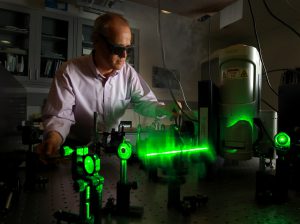
Dr. Randall Ellingson, professor in the UToledo Department of Physics and Astronomy, analyzes the response of solar cells in his laboratory at The University of Toledo.
Ellingson is applying his persistent dedication to discovery in the fast-growing field of photovoltaics to champion the U.S. armed forces by advancing power generation technologies for space vehicle applications to survive natural and man-made threats.
“Our goal is to protect our troops and enhance national security by accelerating the performance of solar cells,” Ellingson said. “Our primary goal is to reduce the power system payload by developing highly efficient and lightweight technology to replace liquid fuels and minimize battery storage needs.”
In order for the technology to achieve both high efficiency and the flexibility to be used on a curved surface like a wing or fuselage, Ellingson’s team is making tandem solar cells – two different solar cells stacked on top of each other that use two different parts of the sun’s spectrum – on very thin, flexible supporting material.
UToledo physicists have had great success drawing record levels of power from the same amount of sunlight using the tandem technique with what are called perovskites, compound materials with a special crystal structure formed through chemistry.
“The University of Toledo is a worldwide leader driving innovation in photovoltaics research, education and application,” Congresswoman Marcy Kaptur said. “This critical collaboration with the U.S. Air Force strengthens national security and fuels a cleaner energy future for generations to come.”
UToledo’s flexible, lightweight, low-cost technology will be tested under space-like radiation exposure.
“In outer space, the radiation environment is much more harsh, where high-energy photons and particles, arising from both our sun and our galaxy, can damage the solar cells,” Ellingson said.
“We are proud our photovoltaics team at The University of Toledo has been selected once again to use its state-of-the-art expertise to advance Air Force missions in service to the nation,” Dr. Frank Calzonetti, UToledo vice president for research, said. “This major award demonstrates the high regard the U.S. Air Force has in The University of Toledo’s solar energy research capabilities and the confidence in our research team. Dr. Ellingson has performed exceptionally well in meeting the high demands of the Air Force in providing research that supports the nation’s defense posture.”
For more than three decades, The University of Toledo has focused with precision on the potential of photovoltaics to transform the world and improve sustainability to combat the energy crisis.
Harold McMaster, an inventor and namesake of UToledo’s McMaster Hall, pioneered the vision for commercializing solar energy in northwest Ohio and donated funds to UToledo to gather great minds and craft solutions.
One of the world’s largest manufacturer of solar cells, First Solar, originated in UToledo laboratories.
The University created the Wright Center for Photovoltaics Innovation and Commercialization in January 2007 with $18.6 million in support from the Ohio Department of Development, along with matching contributions of $30 million from federal agencies, universities and industrial partners. The center works to strengthen the photovoltaics and manufacturing base in Ohio through materials and design innovation.
Algae researchers to fan out across Lake Erie to collect water samples Aug. 7
Friday, August 2nd, 2019Five years after a water crisis in Toledo left half a million residents without safe tap water for three days, environmental scientists from the U.S. and Canada will board research vessels and fan out across western Lake Erie to collect water samples at nearly 200 locations in four hours in a united effort to create a high-resolution picture of this summer’s harmful algal bloom (HAB) and ultimately protect the public drinking water supply.
The second annual HABs Grab on Wednesday, Aug. 7 brings together researchers from The University of Toledo, National Oceanic and Atmospheric Association (NOAA) Great Lakes Environmental Research Laboratory, Ohio State University, University of Michigan, Bowling Green State University, Wayne State University, Michigan Technological University, Cooperative Institute for Great Lakes Research (CIGLR) and LimnoTech. The HABs Grab has nearly doubled in size this year with the addition of Canadian partners, including the University of Windsor, Environment and Climate Change Canada, and the Department of Fisheries and Oceans.
Members of the media are invited at 12:30 p.m. to the UToledo Lake Erie Center, 6200 Bay Shore Road in Oregon, as researchers reunite to process water samples in the laboratory.
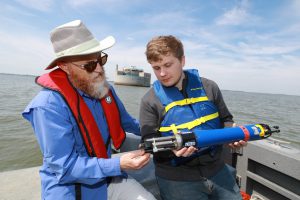 A major goal is to estimate the mass of total microcystin toxin for one day during the peak of algal bloom season as well as to characterize the different forms of microcystin and the genes that produce them.
A major goal is to estimate the mass of total microcystin toxin for one day during the peak of algal bloom season as well as to characterize the different forms of microcystin and the genes that produce them.
“Collaboration is critical in our efforts to understand a harmful algal bloom as large as Lake Erie’s – the lake is simply too large for one organization to handle,” Dr. Thomas Bridgeman, director of the UToledo Lake Erie Center and professor of ecology, said. “This massive one-day sampling event allows us to not only analyze the current bloom, but focus on unraveling the mystery of why some algal blooms are highly toxic, while others are less so.”
Bridgeman, who has studied algae in the Great Lakes for nearly two decades, and his research team at UToledo collect samples and track cyanobacteria throughout Lake Erie’s western basin once a week every summer during algal bloom season.
“Harmful algal blooms are an international issue,” Bridgeman said. “The ultimate solution is to prevent blooms from growing in the first place by preventing water pollution. In the meantime, discovering what triggers a bloom to start producing toxins would be a large step toward protecting people, pets and wildlife.”
HABs Grab is funded by NOAA’s ECOHAB research program.
“The main goal of the project is to develop a bloom toxicity forecast, and the HABs Grab provides data to estimate toxin mass in the lake,” said Dr. Justin Chaffin, leader of the HABs Grab project who is based at Ohio State University’s Stone Laboratory. Chaffin earned his Ph.D. in biology from UToledo in 2013 while studying in Bridgeman’s lab. He also earned his master’s degree in biology from UToledo in 2009.
“This coordinated effort will assist in improving the accuracy of microcystin toxin concentrations in HAB forecast products,” Deborah Lee, director of the NOAA Great Lakes Environmental Research Laboratory, said. “It is a true testament to collaboration and coordination across institutional and international boundaries.”
The Lake Erie Center is UToledo’s freshwater research and science education campus focused on finding solutions to water quality issues that face the Great Lakes, including harmful algal blooms, invasive species and pollutants.
UTMC takes next step in transition to community hospital
Thursday, August 1st, 2019In response to the changing healthcare needs of the Toledo region, The University of Toledo Medical Center (UTMC) has elected to transition to a Level III trauma center.
UTMC notified the American College of Surgeons this week that it desires to change its verification status from a Level I adult trauma center to a Level III trauma center.
“This has been our long-term strategy, and we have been working for several years to transition to a community hospital focused on serving South Toledo,” UTMC CEO Dan Barbee said. “Most recently we have increased our emphasis on primary care and behavioral health, and we will continue to evolve to meet the healthcare needs of our community.”
Earlier this month, UTMC opened the new Comprehensive Care Center, which offers a variety of primary care services, including family medicine, internal medicine, multi-specialty, X-ray and laboratory services, and an on-site pharmacy. Behavioral health services have been expanded in recent years to include inpatient and outpatient recovery services; electroconvulsive therapy, better known by the acronym ECT, as a treatment option for patients with depression; geriatric psychiatry; and child and adolescent psychiatry. Additional services are being discussed based on the community’s needs.
“Our expert physicians, nurses and medical technicians in our emergency department and throughout the medical center remain committed to providing high-quality care to our patients,” Barbee said.
The city of Toledo currently has three Level I trauma programs, making this continued investment unnecessary to fulfill the needs of our community, Barbee said. As part of our long-term strategy, this move enables us to align our operations with the healthcare needs of South Toledo and our surrounding communities.

